Nice jam, nice video. Thanks for sharing!
PS: be careful, a hand behind your rack is trying to steal your system... ;)
'On ne devrait jamais quitter Montauban' (Fernand Naudin).
https://soundcloud.com/petrus-major/tracks
This is my system as shown on my youtube channel Monodux.
You can find tutorials, jams, and a nerdy studio tour there.
If you're looking to build a system based on the Behringer System 55, I've created a template for that here: 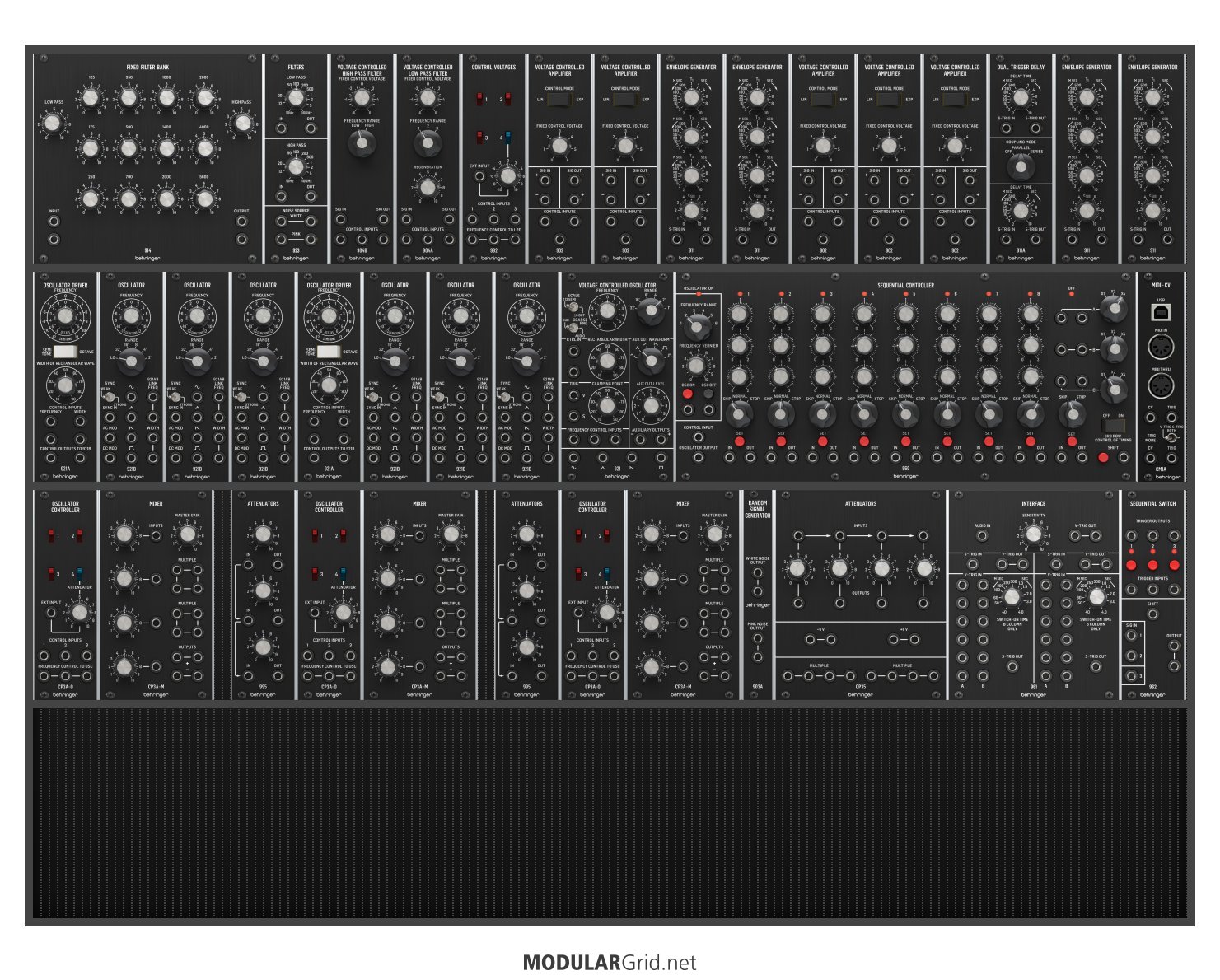
This shows everything as it comes in the box. I have rearranged my own rig for ease of use, placing envelopes and VCAs together in pairs, and removing one of the oscillator controller modules to make space for other stuff. I'm happy to answer any questions.
Cheers,
Monodux
Can we get Nervous Squirrel added as a manufacturer in the drop-down list? They've got three modules available in MG now.
So, would this be an option and work out ok...
Niftycase + audio out cable into focusrite solo 3rd gen? https://focusrite.com/products/scarlett-solo-refurbished?setCurrencyId=1&utm_term=&utm_campaign=&utm_source=bing&utm_medium=ppc&hsa_acc=9998263402&hsa_cam=483555825&hsa_grp=1148991330118347&hsa_ad=&hsa_src=o&hsa_tgt=pla-4575411501436731&hsa_kw=&hsa_mt=e&hsa_net=adwords&hsa_ver=3&msclkid=eceda7b65215191e608cc2167b74e255
-- EuroBadger
Yep, I use a focusrite in my set up to record into Ableton & it works fine
Is it just me or is this a conduit from various A.I. tools into Eurorack?
Some people record direct to a small feild recorder too.... which also means you are setup for collecting found-sounds to later use in the modular.
-- wishbonebrewery
Yes, I have seen a few handhelds - they look very interesting, do the job plus another sound source. I hope to solve the issue of recording at a low cost - maybe a focusrite audio interface to just plug in and use, if that works.
I record into ableton from the nifty case with midi to my audio interface.
-- MCGM
So, would this be an option and work out ok...
Niftycase + audio out cable into focusrite solo 3rd gen? https://focusrite.com/products/scarlett-solo-refurbished?setCurrencyId=1&utm_term=&utm_campaign=&utm_source=bing&utm_medium=ppc&hsa_acc=9998263402&hsa_cam=483555825&hsa_grp=1148991330118347&hsa_ad=&hsa_src=o&hsa_tgt=pla-4575411501436731&hsa_kw=&hsa_mt=e&hsa_net=adwords&hsa_ver=3&msclkid=eceda7b65215191e608cc2167b74e255
Enjoy the spare space for a while and maybe you'll find out which modules you actually need by using what you've got ;-)
Maybe something to pan stereo and mono signals would be an advantage so you could ditch one of the STMix's.
Enjoy your spare HP, don't rush to fill every last space, this is not like filling sticker books. Resist the urge to 'complete' your rack, its never complete so just relax.
Some people record direct to a small feild recorder too.... which also means you are setup for collecting found-sounds to later use in the modular.
Enjoy your spare HP, don't rush to fill every last space, this is not like filling sticker books. Resist the urge to 'complete' your rack, its never complete so just relax.
But to answer your question, I use distings mk4 in wav recorder mode to record anything I make in modular,
-- Sythic
I do like the idea of a self contained case...will remeber this if I dont get the 4ms one day, thanks
There are a few options for recording out but honestly there a lots of low cost USB audio interfaces available that would do this for you & that would cost less that buying a dedicated module.
You could use the remaining funds & HP you would save (niftycase is quite small) to get something else to put in the case.
-- Traxam
This is looking like the plan I may take, thankyou...having everything contained in the case including ability to record would be great one day. But I don't think it is right now.
Are there any usb audio interfaces you would recomend? I have seen alot of focusrite.
I would apriciate some feedback on mz case. I have some space for some more modules. Like to hear zour thoughts.
My rack 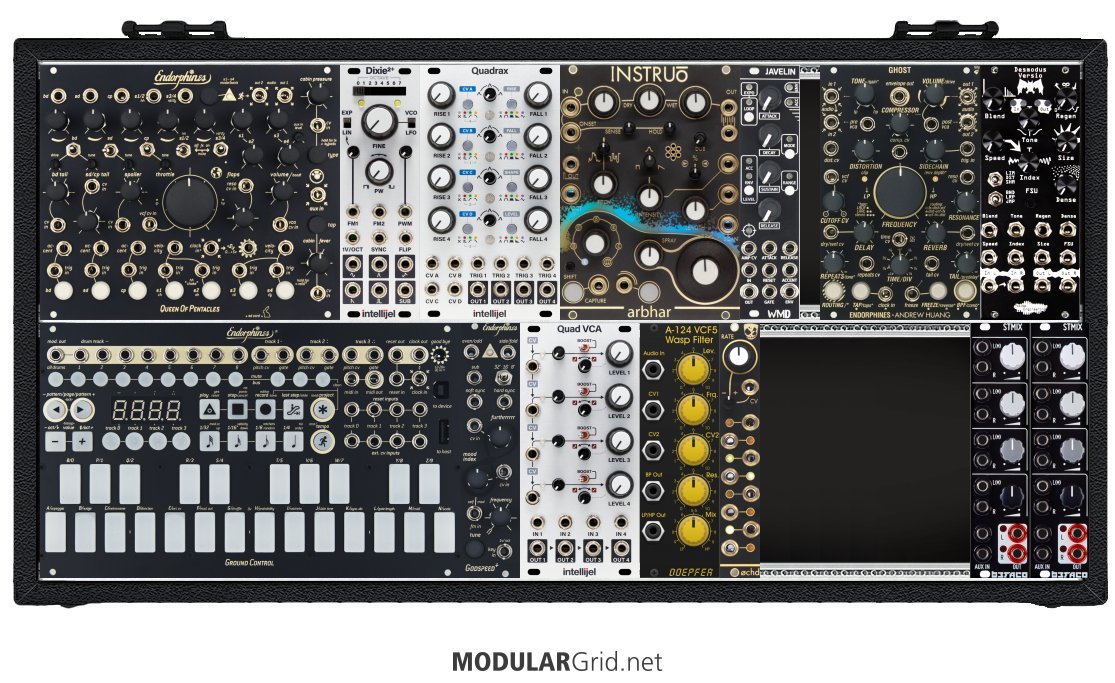
Thanks
I cant see any obvious ways you would create midi values within your case to send via a midi out.
Midi isnt audio, its a data feed, it can hold note values, or similar e.g. velocity info (typical in a midi compatible keyboard), or it can send control signals which might be equialent to mapping a midi controller knob to an ableton knob, so that one affects the other.
But to answer your question, I use distings mk4 in wav recorder mode to record anything I make in modular, and then also use the audio out from the disting mk4 into my octatrack then on to my speakers. I pop the micro SD card in my laptop when I want to convert a recording to mp3 and share
There are a few options for recording out but honestly there a lots of low cost USB audio interfaces available that would do this for you & that would cost less that buying a dedicated module.
You could use the remaining funds & HP you would save (niftycase is quite small) to get something else to put in the case.
Hello,
Here is an example of a setup that I think would be a fun way to fill out your case:
- Added Quadrax in there for some additional modulation sources. It has several different modes, including envelopes and LFOs. Just an all-around useful module to have.
- Added the Desmodus Versio in there to have a versatile reverb effect. The Versio platform also allows you to easily swap the firmware for something different, like a delay or distortion, for example. This would allow you to try out several different module types without any additional cost.
- Added the 3x MIA in there as an additional way to mix your oscillator's waveforms and/or modulation sources, as well as control modulation levels, which is really handy with a module like the Versio. 3x MIA is one of the best modules in all of eurorack, in my opinion.
- Had two HP left and I thought a dedicated headphone out (the HPO) would be nice to have.
The Quadrax and Desmodus are a bit more expensive, but they are worth it, in my opinion. I see them as modules to keep for life, as they will always be useful in some way or other. Same goes for the 3x MIA.
I hope some of that is helpful! Let me know if you have any questions.
-Chace
I record into ableton from the nifty case with midi to my audio interface.
Why does it not work?-- MCGM
I don't own an audio interface. Nifty case plus the midi cable i recieved today which are 1 in and 1 out din ports...but case has no midi out ( a midi thru instead).
I record into ableton from the nifty case with midi to my audio interface.
Why does it not work?
Greetings
Chris
Hello, I am currently trying to sort out recording my audio from my rack, discovering that my niftycase is not as nifty as first thought. Yes it has many sockets but not midi in / out ( has midi in / midi thru) so I can't use my midi cable and record using Ableton lite or anything for that matter.
I am wondering would the best option be to use a dedicated recording module within my rack -
such as 4ms record https://www.modulargrid.net/e/4ms-company-wav-recorder
within my rack https://cdn.modulargrid.net/img/racks/modulargrid_2316440.jpg which as you can see is tight for space. I was looking at the Big T music Veils for my vca which would complete this case - possible Rackbrute 6u if able midway through the year. But this can wait as focus is being able to save.
So any advice on recording options would be a huge help - thanks in advance.
A filter based on the 2600 from the seventies and uses the LM3900 Norton opamp chip.
Straightforward kit, would be good 1st or second kit.
And sounds great, good modification options also.
Build
I think it's pretty balanced in terms of functionality. Depending on what your goals are, you can always add [insert your favourite function here] , but as a starting system I'd say you have everything you need.
Hi,
Is there a way / hidden fonction, to use the voltageBlock as a “normal” sequencer with each step of the panel corresponding to the note of a “track” . As for example the “voltage multistage of verbos electronics”
Could we hope for that kinf of firmware update ?
Thx

I've been kinda slow getting my rack up but this is what I have so far. Is there anything in particular I'm missing? Also I know I have a lot of Behringer modules here but I got them before having knowledge of the fact that they're not a great company.
Link to my rack
I just had the binoculars out looking for the birds ;-) Nice.
-- wishbonebrewery
I miss the birds this time of year. My house backs up to a small lake and we live in a wooded area. Birds and all kinds of wild life during the spring, summer, and fall. I was quite excited when i made the bird sound :)
I do stuff and things and whatnot...
Looks pretty balanced overall from a functionality standpoint, but it does seem like there are a ton of mults for a rack of this size. If you use them, more power to you, it's just the one thing that stuck out to me.
As (I'm guessing) other users will chime in to say, you might stand to add a couple of utilities in place of two of the mults (if they're not crucial to your sound). Something like a quad switch or precision adder might be worth looking into.
Best of luck and hopefully the more seasoned users will chip in with more informed suggestions!
“You must have chaos within you to give birth to a dancing star.”
― Friedrich Nietzsche
... Can you just use some special cables in place of the small shunts that currently need to be physically moved from the LPF pins to the HPF ones? Is this what you mean by jumper cables? Thanks!
-- thermal
you can replace those red jumpers
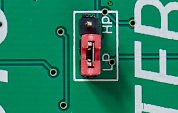
with "Arduino Jumper wires"
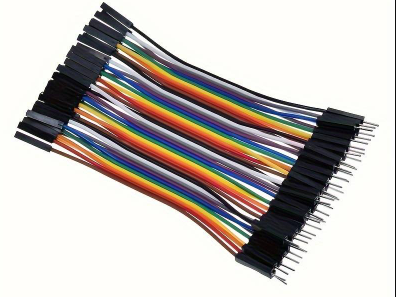
connected to any SPDT switch (center pin on PCB to center pin on switch)
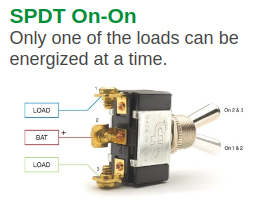
if you need further assistance feel free to PM me to keep this thread module specific...
hey that's a cool idea. Don't reckon I have the DIY skills required though. Can you just use some special cables in place of the small shunts that currently need to be physically moved from the LPF pins to the HPF ones? Is this what you mean by jumper cables? Thanks!
...Bit of a shame there aren't switches for this on the face of the module as it's a pain to take the module out mid session to swap the jumpers on the back...
-- thermal
in case you have 2HP left it shouldn't be that hard to turn a blank panel into a non-destructive breakout module with a few small switches.
with long jumper cables it also would be possible to place this breakout module in the row above or below...
two years ago i made something similar https://www.modulargrid.net/e/other-unknown-a-128-bypass-breakout
Ok so I have had the modules for about a week and first impressions are good. Sturdy build quality and nice feature sets. Have my Dual Filter set to LP+HP. Cool that I can switch to dual LP or HP for stereo filtering if desired. Bit of a shame there aren't switches for this on the face of the module as it's a pain to take the module out mid session to swap the jumpers on the back. On the other hand it's great to at least have the option. Another slight gripe is the mini knobs for attenuating the various inputs. The panel is pretty crowded, especially with a few cables plugged in, which makes tweaking the knobs kind of a surgical procedure. Compared to not having attenuators/attenuverters at all, though? A real bonus.
Both the LP and HP sound great. I suppose they are fairly clean for an MS-20 style filter, but there's still a lot of character to the sound.
The Dual ADSR is deep and I haven't gone to town with it yet. But it's very versatile and modulating the individual stages separately is awesome. The sliders are nice as well.
Hi there,
I just would like to know what do any of you think of my very first system here:


All i have to say is that i'm pretty happy with it for the moment... but i'm open to any suggestion to make it even more enjoyable :-)
Thanks in advance for your feedback.
Cheers
Vinz
Sounds good!
Paradiso, eh? That's a niice venue! :)
Break a leg!
“You must have chaos within you to give birth to a dancing star.”
― Friedrich Nietzsche
Subscribed.
Enjoy your spare HP, don't rush to fill every last space, this is not like filling sticker books. Resist the urge to 'complete' your rack, its never complete so just relax.
Thank you for all the responses!
I understand the opinions towards Behringer. But financially I have the choice of either get Behringer for my first setup or no modular at all.
Behringer was my gateway drug into synths in the first place, now it's my gateway drug into modular.
If I had the luxury I'd get a completely different setup, but that would cost loads more. The Mordax DATA already was a very hurtful experience for my wallet.
But recently I learned about self-build kits which are cheaper, so I'm looking into that (Dreadbox for example).
Now that I have this setup to start with, I can save money to expand this system with better quality and brand modules.
About the layout: I'm still working on it, I'm restricted with the depth of the case on the bottom row and I need to get a feeling on what works best.
Hello! At the 21st of january I am performing at Voltage Control Amsterdamin at Paradiso. So the next two weeks Im in rehearsal mode. I thought it would be fun to take you with me in the process of creating the performance. Enjoy the music!
Raaf
https://www.modulargrid.net/e/forum/posts/index/801
--- Voltage control all the things ---
Hi there,
I recently released a video Eurorack module which is currently for sale called "Video Breaker".
I already added it to modulargrid some time ago but waited for the release to ask, is it possible to have my brand, Melted Electronics, added, so that it doesen't show up as "other/unknown"?
All the best,
Martino
I recommand @polykobol for the good transaction we did, thank you :-)
I just had the binoculars out looking for the birds ;-) Nice.
Enjoy your spare HP, don't rush to fill every last space, this is not like filling sticker books. Resist the urge to 'complete' your rack, its never complete so just relax.
Good morning,
At first the system seems balanced. I wouldn't change anything in terms of functionality. Another thing is the personal opinion about the manufacturer or the layout of some modules. But this is already an opinion that does not influence the results you want to obtain. Good luck!
As @AEROCATONE explains, there are some (good and bad) controversies on a certain number of modules in your setup; you probably know that. Personally, what interests me the most will be to know how you’ll evaluate your system, your modules: technically, musically, etc. Will you please let us know in a few weeks? Thanks in advance!
'On ne devrait jamais quitter Montauban' (Fernand Naudin).
https://soundcloud.com/petrus-major/tracks
I recently have been looking for a good fuzz for bass gutiar, and these two in particular piqued my interest. Does anyone have experience with either of these pedals on bass, preferences between the two, or other reccomendations for a solid bass fuzz?
Finally got around to mixing this today... Ran out of time on new years and going back to work after sever weeks out needed some decompression time... On top of that I have been reading code and code examples for my new Patch.init() module :-D.
This started out as me experimiting with different drum/kick/base and filtering them and pushing through FX. I accidently found a nice bird like trill and ran with it.
I do stuff and things and whatnot...
This is my first eurorack. I ordered everything, within the coming weeks modules will arrive depending on availlability. Is there anything I am missing? Like, do I have enough VCA, EG, VCF for this setup? I'd love some input please. Sequencing will happen mainly externaly with midi or gate-cv out from my Deluge. I added a sequencer for fun, but also because all my midi channels are filled already.
-- LordWiggle
Most peeps won't comment on your thread because of the B word. However, you have a solid system here, capable of doing most anything you need. My suggestion is master it before adding to it. Enjoy the adventure...
over:under
Messy but I like the bird-like jungle ambience tweety stuff!
Enjoy your spare HP, don't rush to fill every last space, this is not like filling sticker books. Resist the urge to 'complete' your rack, its never complete so just relax.
Thanks for the manual, ivager! Would it be possible to get a higher resolution picture of the manual, maybe an external link?
I would patch a simple voice with a single sawtooth or square. Then find a sequence I like in marbles. Set a Euclidean sequence in Pams. Then build on that sequence with sound design and effects. Like put the batumi before the CSL and patch the F%^& out of it. Or use the OCHD.